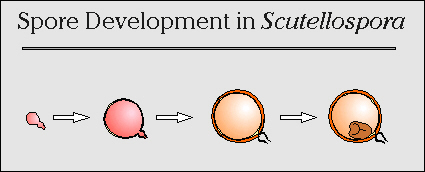Scutellospora Walker & Sanders
| Term | Description |
|---|---|
| Etymology: | Latin, “shielded” Greek, “spore” |
| Description: | Spores with or without ornamentations. Spores consist of a bilayered spore wall and two bilayered flexible inner walls. Germ tubes arise from a persistant, plate-like germination shield that is always associated with the innermost flexible wall. Thin-walled auxiliary cells with smooth to knobby surfaces, are produced on hyphae in the soil near the root surface. |
| Type species: | S. calospora (Nicol. & Gerd.) Walker & Sanders |
Spore Development

Early stages in spore development mirror those in the sister genus, Gigaspora. Spores develop blastically from a hyphal tip, which swells and becomes the “sporogenous cell”. After the sporogenous cell reaches it’s full size (usually about 25-50 µm in most species), the spore begins to develop at the tip. The outer layer and the laminate layer develop simultaneously, and often cannot be distinguished in juvenile spores without the assistance of Melzer’s reagent. The laminae then thicken and the outer ornamentations develop (if present in the species). Inner walls develop and the last stage is the formation of the germination shield.
Literature Cited
- Walker, C. and Sanders, F.E. 1986. Taxonomic concepts in the Endogonaceae: III. The separation of Scutellospora gen. nov. from Gigaspora Gerd. & Trappe. Mycotaxon 27: 169-182.